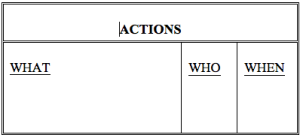Meetings are more powerful and effective with an implementation, next steps, or action component. But while many groups agree on where they want to go and what they need to do, few plan how to get there. This often results in conflict, confusion and diminished effectiveness. Gaining agreement on how these group decisions will be carried out strongly increases the likelihood of success.
The 15 Techniques for Implementing Decisions demonstrate how to efficiently move a meeting group toward action. These techniques ensure agreement on actions, clarify roles and responsibilities, and formulate plans for review and follow-up.
Techniques include:
- Chart Actions
- SMART Goals
- Test for Support
- Individual Action Planning
- Force Field Analysis
- Goal Plan Go
- Transformation Maps
- Project Charters
- Project Teams
- Project Plans
- Executive Steering Group
- Progress Reviews
- Roles and Responsibility Charting: RACI
- Stakeholder Identification and Planning
- Sustainability Analysis
This blog highlights Technique #1: Chart Actions.
“We often agree to do things in our meetings, but forget exactly what the agreements were by the time the next meeting begins. We get in arguments about when things are supposed to be finished and who is supposed to do them. Is there a technique that can help us avoid these problems?”
#1: Chart Actions
What is Chart Actions?
The Chart Actions technique enables you to document agreed upon actions as they are discussed in a meeting. This technique articulates “who will do what by when,” and is an excellent way to move from vague action statements to specific actions plans.
The Chart Actions technique clarifies exactly what actions are agreed upon and when these actions will be accomplished. The process also publically identifies the person(s) who are accountable for each action, thus providing incentive that the actions will be fulfilled. These elements, when coupled with effective follow through and monitoring, will contribute to the success of any action plan.
When to Use Chart Actions
- Whenever your group is discussing issues that require action.
How to Use Chart Actions
- When your meeting group will be discussing issues that require action, create a chart labeled Actions or Next Steps at the beginning of your meeting. Include three columns, headed by What, Who, and By When, as shown in the example below. Place the chart at a convenient spot in front of the room.
- As ideas for action come up during the meeting, write them down in the What category. At that time, add both the Who and By When if they are clear. If the Who and By When are not clear, wait until the end of the meeting for clarification so as not to disrupt the flow of the meeting.
- As one of the last agenda items at the end of the meeting, go back to your chart. Lead a discussion to affirm Who will do What by When for each action item displayed.
NOTE: Sometimes draft actions will be ideas that the group will not want to follow through on and sometimes actions will be tabled until a later meeting. Most actions, however, will be appropriate to be documented as a next step.
NOTE: Don’t get bogged down. If an action is controversial and you don’t have time to discuss it during your meeting, make an agenda item to discuss this action at a later date, such as at the next scheduled meeting.
- Follow up as appropriate and necessary for each action item. Ensure actions are distributed to participants after the meeting. This can be as a subset of the minutes of the meeting or as a stand-alone document.
NOTE: It is beneficial to return to this action list at the beginning of each subsequent meeting until all actions are complete. Public follow-up greatly motivates people to accomplish what they promised to do.
In Summary:
The Chart Actions technique enables you to document actions or next steps as they are discussed and approved in your meeting. More specifically, the process identifies “who will do what by when.”
- Create a chart labeled Actions or Next Steps at the beginning of your meeting. Include three columns, headed by What, Who, and By When.
- As ideas for action come up during the meeting, write them down in the What category. Add the Who and By When if they are clear at this time.
- As one of the last agenda items at the end of the meeting, go back to your Chart Actions chart to affirm who will do what by when.
- Follow up as necessary with each action item.
———————-
NOTE:
If you would like to receive e-mail notification when I post additional techniques, please sign up through this link. http://eepurl.com/KILan You may unsubscribe at any time.
You will find my book Mission Critical Meetings: 81 Practical Facilitation Techniques on Amazon. Your feedback and reviews are most welcome.
